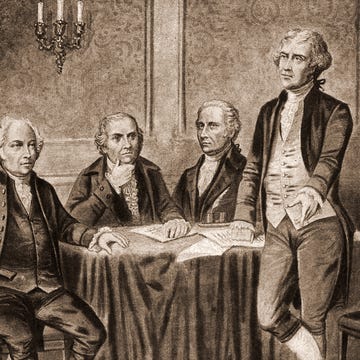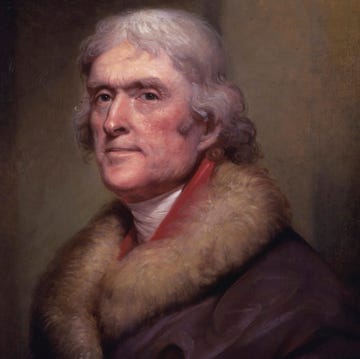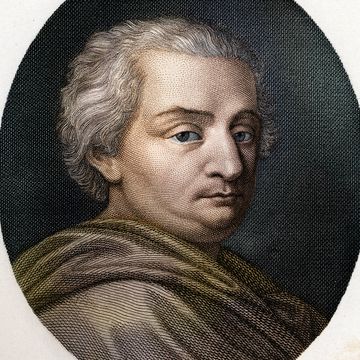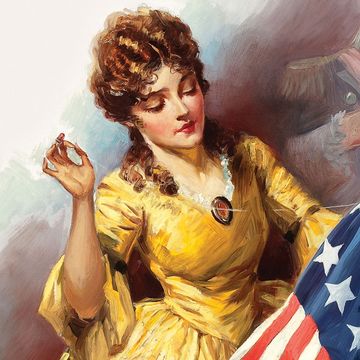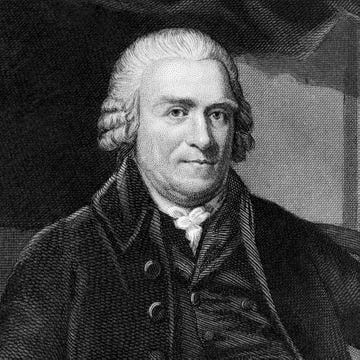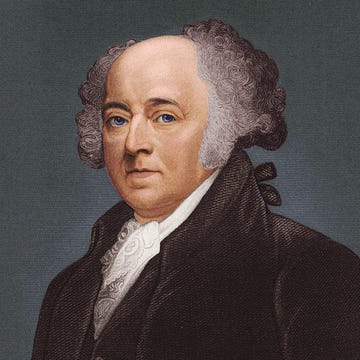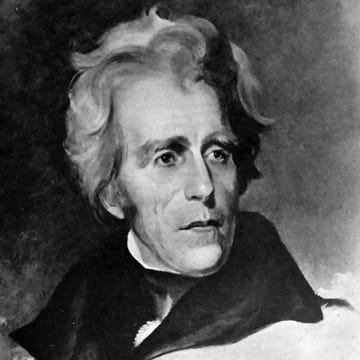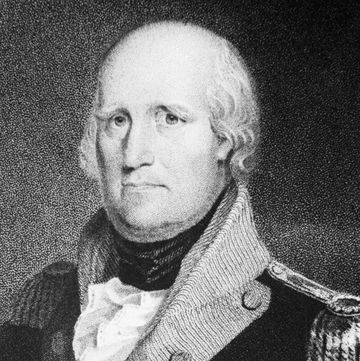Henry Wadsworth Longfellow’s famous poem “Paul Revere’s Ride,” taught in classrooms across the United States for over a century, begins with the line: “Listen, my children, and you shall hear of the midnight ride of Paul Revere.” But if that poem is the only way you’ve ever heard of Revere’s famous ride, then you haven’t really heard it right.
Revere saddled up April 18, 1775, but it wasn’t until 86 years later that Longfellow composed his well-known poem. In doing so, he pulled the Boston silversmith from the lesser-read pages of America’s nascent historical record into the realm of folk hero. The stirring verses from the famed poet, who lived in George Washington’s former military headquarters, helped elevate Revere’s legacy to just below that of Washington, himself, thanks to harrowing descriptions like that of the “one if by land, two if by sea” lantern signal that, by Longfellow’s account, ignited Revere’s travels to warn the colonists of impending invasion. For the poet, no less than “the fate of a nation was riding that night.”
But just as a modern Hollywood biopic takes poetic license with a story only for fiction to overtake fact about its subject, so too has Longfellow’s poem impacted our collective understanding of Paul Revere’s ride 250 years ago. The importance of the lanterns and the phrase “the British are coming” are both cases of dramatic flair added over the years, either from Longfellow’s pen or anecdotes misremembered as the legend of Paul Revere grew. In real life, Revere wasn’t even the only rider giving warning that night, and it wasn’t actually Revere who reached Concord, Massachusetts, at all.
What really happened on Paul Revere’s midnight ride
Revere had already been involved in carrying messages before his most famous journey. He was part of one of America’s earliest intelligence organizations, who referred to themselves as “the mechanics.” Just 11 days before his midnight ride, Revere traveled to Concord to warn the Massachusetts Provincial Congress of possible troop movements from the British army, then referred to as the Regulars.
The same man who sent Revere to dispatch that information, Dr. Joseph Warren called upon him on the night of April 18th. This time, the intel Warren had gathered told him that the Regulars were set to move by sea from Boston to Concord, then a major hub of military supplies for the Patriots.
Warren’s intel also indicated they would first stop at Lexington to arrest rebel leaders Samuel Adams and John Hancock. This latter piece of information was actually inaccurate. Although William Legge, Earl of Dartmouth, had instructed British General Thomas Gage to seize the weapons at Concord and arrest the aforementioned rebel leaders, Gage felt the arrests weren’t a good idea, as they could stir an uprising. Ultimately, the general only instructed his men to disarm the rebels.
Regardless, this was the intel Warren had, and he needed it conveyed urgently and secretly. Rather than rely on a single man, as the Longfellow poem suggests, Revere was actually one of two men Warren dispatched from Boston that evening. He had already sent out William Dawes to take a different route than Revere’s to Lexington, to ensure someone would convey the message in the event the other rider was intercepted.
Longfellow could have just as easily written “Listen, my children, and give some applause for the midnight ride of William Dawes,” and it would have been just as accurate. The poet would have likely had a harder time finding a rhyme for the third rider, Samuel Prescott, who crossed paths with Revere and Dawes during their ride that night and was recruited to join them.
Before he departed for Lexington, Revere implemented the more famous failsafe measure for the operation. He instructed sexton Robert Newman and vestryman John Pulling to climb to the bell tower of Boston’s Christ Church and place two lanterns signaling the British approach by sea. In the event the riders were intercepted, this backup would still provide notice to local militia. Longfellow correctly credits Revere for instituting the signal in his poem, but the “gleam of light” from the lamps weren’t what set him on his journey—Warren was.
Revere took a small boat across the Charles River, narrowly avoiding the warship HMS Somerset, and arrived at Charlestown. There, he mounted a horse and set off for Lexington and Concord. En route, he evaded capture a second time; so, he wasn’t about to give himself away by loudly shouting “The British are coming!” down the streets of Lexington when he arrived. Revere, in fact, wouldn’t have called them “the British” at all, since most colonists at the time would have called themselves British as well.
So where did the famous phrase come from? According to the Paul Revere House, “the first time the phrase seems to pop into the historical record seems to be from an 1822 dinner party that included Dorothy Scott, previously Dorothy Hancock, who was John Hancock’s fiancé at the time of the Midnight Ride, and on scene for the action in Lexington.” An attendee at the party recalled Scott, who had remarried after Hancock died, recounting that on that fateful night a man came by the house to shout “the British are coming” after seeing British bayonets. But this recollection came decades (not to mention an entire other war, the War of 1812) after the events of Revere’s ride.
What we know he said comes from a more reliable source: the account of the sentry who guarded the house Adams and Hancock occupied in Lexington. When Revere arrived, the sentry reportedly scolded Revere for making too much noise while everyone inside was asleep. “Noise!” Revere is purported to have exclaimed, “You’ll have noise enough before long. The Regulars are coming out!”
Dawes soon arrived to meet with Revere, and after warning Adams and Hancock, the two set out for Concord. On their way, the two were overtaken by a third rider, Samuel Prescott. Although Longfellow writes Revere went to Concord in his poem, Prescott was the only one of the trio to make it there and deliver the message.
The three men were ensnared in a roadblock by Regulars. Prescott was able to make a swift escape on his horse, and Dawes, too, was eventually able to get away (though he fell off of his horse shortly thereafter and never completed the mission). But Revere’s reputation preceded him, and the British Army wouldn’t let him get away. They attempted to bring Revere in with their other prisoners until gunfire was heard ringing out from Lexington. Revere’s horse was then confiscated as the King’s soldiers took off to warn others of the firefight.
Instead of going to Concord to finish his task, Revere made his way back to Lexington on foot. There, he helped John Hancock and his family escape during the fray that followed at Lexington Green.
The battles that ensued at Lexington and Concord are remembered today by a phrase from a different poem, 1837’s “Concord Hymn” by Ralph Waldo Emerson. He referred to the guns fired by the “embattled farmers” on that night as “the shot heard round the world.” The British had intended their march on Lexington and Concord to be a means of suppressing a growing rebellion by confiscating weapons before they could be turned against the forces of the King. But thanks to Revere, Dawes, Prescott, and the sophisticated espionage system of the Sons of Liberty, the local militias were able to arm, assemble, and ultimately outnumber the British forces. These battles, instead of quelling a rebellion as intended, instead marked the beginning of the American Revolution.
Longfellow’s poem speaks to an ideal America
So why did Longfellow’s poem stray so much from the facts? Perhaps it was just poetic license. Perhaps Longfellow simply misremembered the facts from some historical account he’d read or heard years before. Or perhaps because, to Longfellow, he wasn’t really interested in writing about a real man at all.
It’s possible that instead, Longfellow was attempting to capture “the idea of America.” As professor and journalist Jill Lepore has suggested, it might be no coincidence at all that Longfellow’s poem, in the pages of The Atlantic Monthly’s January 1861 issue, hit Boston newsstands on the same day South Carolina seceded from the Union: December 20, 1860. Lepore posits that Longfellow’s poem is “about waking the dead. The dead are Northerners, roused to war. But the dead are also the enslaved, entombed in slavery.”
Longfellow used a figure from America’s past to explore the very idea of America at a time when the nation was in turmoil. (The Civil War broke out roughly four months later in April 1861.) Through his poetry and this fictionalized version of Paul Revere, Longfellow sought to depict America itself, in a manner fellow poet Walt Whitman would later describe as “Perennial with the Earth, with Freedom, Law and Love, A grand, sane, towering, seated Mother, Chair’d in the adamant of Time.”
The legend of Paul Revere, as Longfellow told it, speaks to an idea of America that so many of us wish to believe in: the power of the individual in the face of authority, the might of a single voice in the darkness, the cause of freedom winning out through sheer willpower.
In The Man Who Shot Liberty Valance, a cowboy drama movie filmed about 100 years after Longfellow published his poem, there is an oft-quoted line at the story’s twist conclusion: “This is the West, sir. When the legend becomes fact, print the legend.”
Revere played additional roles in the American Revolution
This doesn’t mean Revere wasn’t a noteworthy part of the American Revolution. His contributions to the cause were actually plentiful, even without the famed midnight ride. Before the war, he was a Son of Liberty who took part in the Boston Tea Party. As a craftsman and artisan, his copper engraving of the 1770 Boston Massacre allowed the illustration to be published far and wide, helping shift colonist sentiment against the British.
During the war, Revere broke new ground in battlefield medicine, according to the New England Historical Society. In March 1776, he was able to identify a fallen soldier on the Bunker Hill battlefield as Dr. Joseph Warren, his former midnight ride conspirator, by recognizing the dentures he had made for Warren (from walrus teeth and iron). Thus, Revere was America’s first forensic dentist.
When Revere died in 1818, his obituary in the Columbian Centinel hailed him as “one of the earliest and most indefatigable patriots and soldiers of the Revolution,” but there wasn’t a single mention of the now famous “midnight ride.” It wasn’t until Longfellow’s poem, written 42 years after Revere’s death, that the events from that night became the most prominent part of the revolutionary’s legacy.
Michale Natale is a News Editor for the Hearst Enthusiast Group. As a writer and researcher, he has produced written and audio-visual content for more than fifteen years, spanning historical periods from the dawn of early man to the Golden Age of Hollywood. His stories for the Enthusiast Group have involved coordinating with organizations like the National Parks Service and the Secret Service, and travelling to notable historical sites and archaeological digs, from excavations of America’ earliest colonies to the former homes of Edgar Allan Poe.










